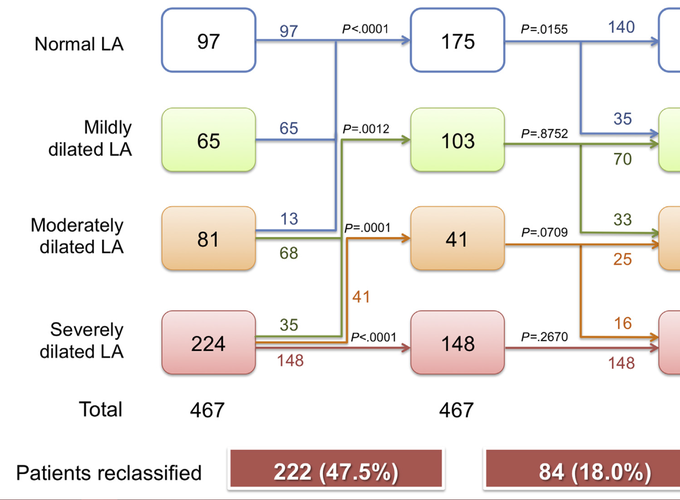Clinical and Prognostic Implications of Methods and Partition Values Used to Assess Left Atrial Volume by Two-Dimensional Echocardiography
 Reclassification of LA volume abnormality applying different cutoff values and different methods of its assessment.
Reclassification of LA volume abnormality applying different cutoff values and different methods of its assessment.
Clinical and Prognostic Implications of Methods and Partition Values Used to Assess Left Atrial Volume by Two-Dimensional Echocardiography
Abstract
Background: The 2015 American Society of Echocardiography/European Association of Cardiovascular Imaging recommendations for chamber quantification suggest new abnormality threshold and severity partition values for left atrial (LA) volume that are equally valid for the biplane method of disk (MOD) summation and the area-length method (ALM). However, they have never been clinically validated. Thus, we compared the clinical and prognostic impact of LA volume assessed by MOD and ALM by using both the 2015 and 2005 abnormality thresholds. Methods: In a retrospective study of 467 patients with sinus rhythm and various cardiac conditions (median age 61 years, 68% men), maximal LA volumes were measured with MOD and ALM. Patients were followed for 3.7 ± 1.1 years to record both all-cause mortality and cardiac death. Results: Applying the 2015 cutoff values, 21% of patients with dilated LA according to the 2005 recommendations were reclassified as normal. Severity of LA dilatation was reclassified in 48% (222⁄467) patients. ALM provided significantly larger LA volumes than MOD (41 [32; 58] mL/m2 vs 39 [30; 55] mL/m2; P = .0150), reclassifying 18% (84⁄467) of patients. Patients who died had larger LA volumes measured with both MOD (57 [38; 77] mL/m2 vs 37 [30; 51] mL/m2; P < .0001) and ALM (58 [40; 82] mL/m2 vs 40 [32; 54] mL/m2; P < .0001). Regardless of the method used, LA volume was a significant factor associated with mortality, with both the 2015 and 2005 cutoff values providing similar prognostic power. Conclusions: The use of 2015 partition values and different methods of LA volume measurement leads to significant changes in patients’ clinical profiles. LA enlargement is an important prognostic indicator independent of cutoff values and methods used. Care should be taken to ensure consistent measurements and interpretation of two-dimensional echocardiography LA volume during patient follow-up.